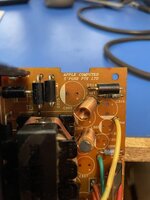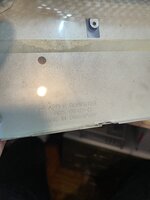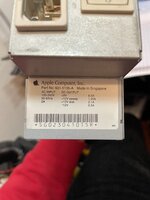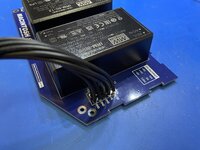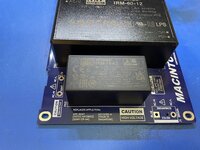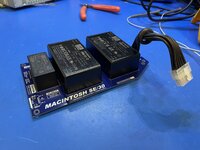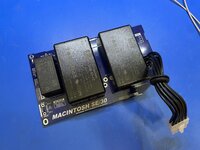Next, in terms of the circuit, the reason why the SE/30's 12V power supply has a Di (SONY ERA81-004, Astec FE2A) between the two rails is that it clips (suppresses) the unregulated 12V for the disk drive to around 13.0V to match the regulated 12V for the sweep, so that the voltage doesn't become too high.
Max. Disk 12V = Sweep 12.0V+Forward Drop Voltage (1.1 to 0.98V)
ERA81-004 40V, 1A VF=0.55V (x 2pcs)
FE2A 50V, 2A VF=0.98V
There is no need to insulate the 12V on the disk side from the 12V on the sweep side.
This is because the windings in the transformer (T151 for Sony, 06890 for Astec) are separated for each 12V to generate independent 12V DC, and if you connect it with a diode, the 12V on the disk side will be linked to the sweep voltage as shown in the following formula, and it will no longer be "independent", and you will lose the reason why it was generated independently from the transformer.
If spike output from the Sweep side is a problem, I think it would be common for electrical engineers to incorporate a diode for this purpose on the analog board as a output safety circuit, so I think it is reasonable to assume that the reason the diode is connected to the output of the voltage regulator on the power supply unit side is to utilize the "(stabilized) 12V output of the voltage regulator" (for the purpose of clipping).
*
From the above, my conclusion is that the reason there are two rails in the SE/30 12V power supply circuit is that the voltage regulator is only needed in a limited number of places, so they used only the voltage regulator with the appropriate capacity and saved on the rest, and the diode was inserted to suppress the upper limit of the 12V required for the disk by saving on the contrary.
What I did is the same as what superjer2000 and his colleagues achieved with their ATX power supply, which is that it's no problem to have just one 12V rail.
*
Over 30 years have passed since the SE/30, and voltage regulators have become much more stable, faster, and less susceptible to noise. Capacitors and noise filters have also become more powerful. Considering this, there is no need to use the exact same configuration as the SE/30, and it is fine to use a DC-DC converter currently on the market that provides +12V, -12V, and +5V.
I used the MeanWell RT-85B three-output power supply unit as an alternative power supply unit for the SE/30, and was able to run the Xceed Grayscale display and the 68050 Accelerator SE/30 POWERCACHE, which is directly attached to the CPU socket, simultaneously on the SE/30 without any problems.
What I did is the same as what superjer2000 and his colleagues achieved with their ATX power supply, which is that it's no problem to have just one 12V rail.
 68kmla.org
68kmla.org
 68kmla.org
68kmla.org

